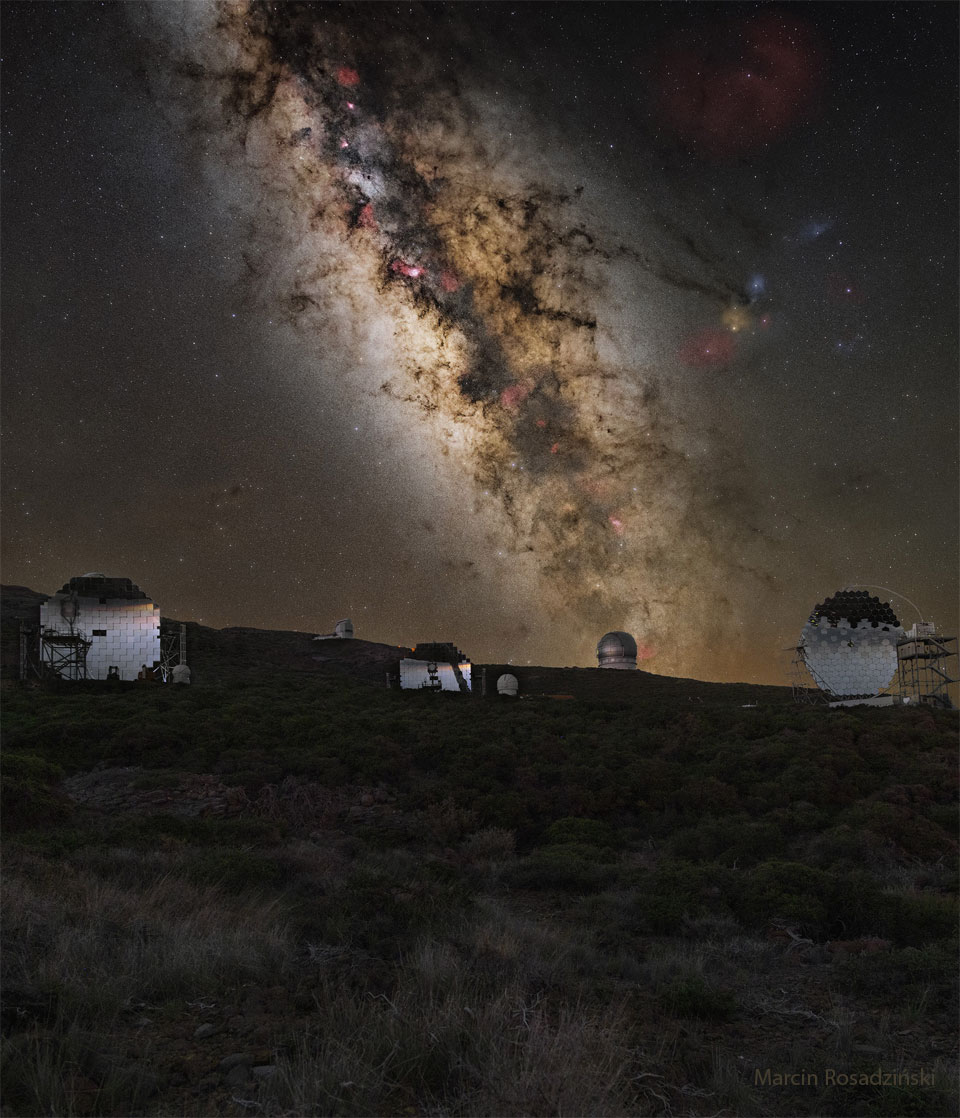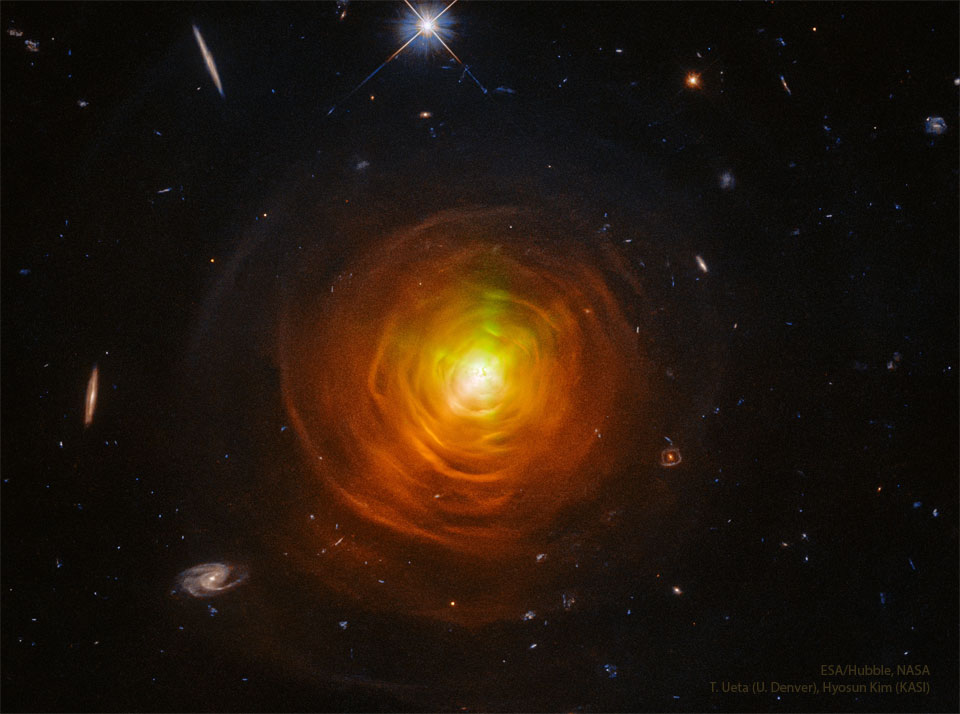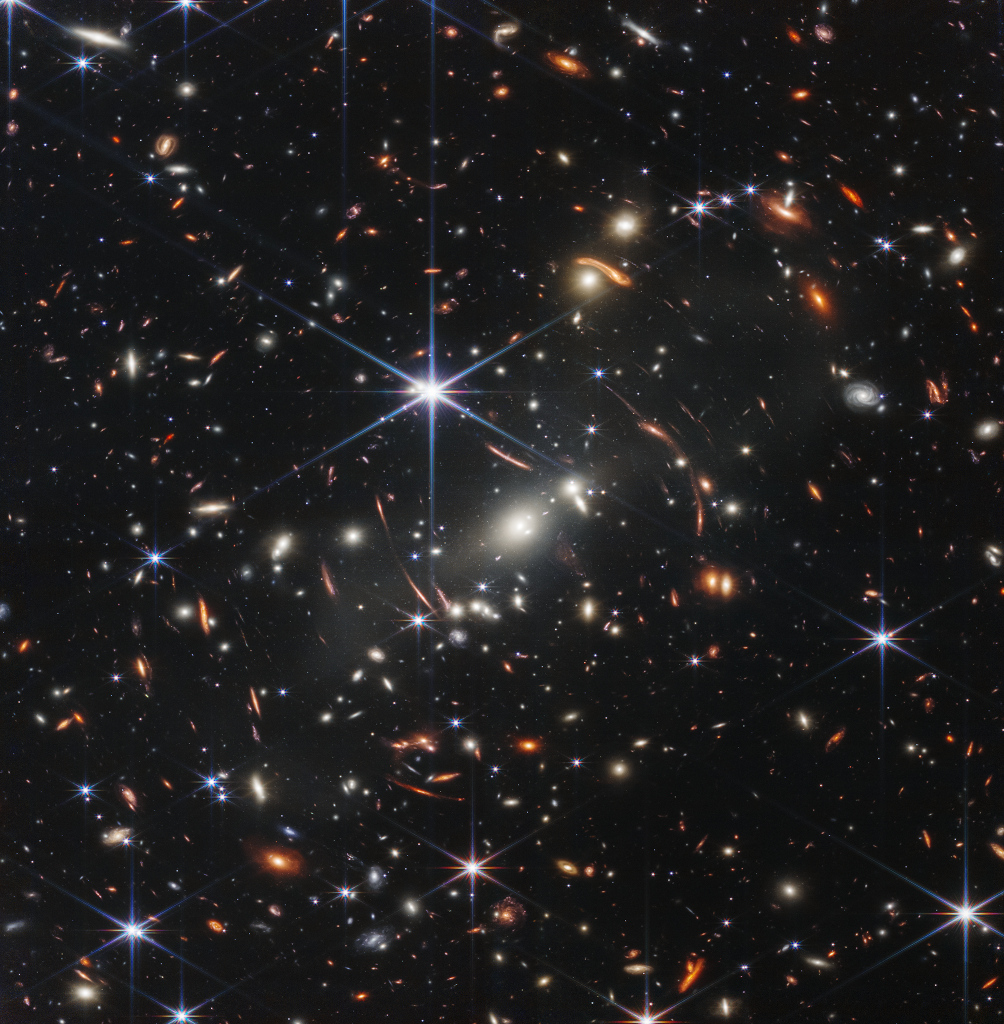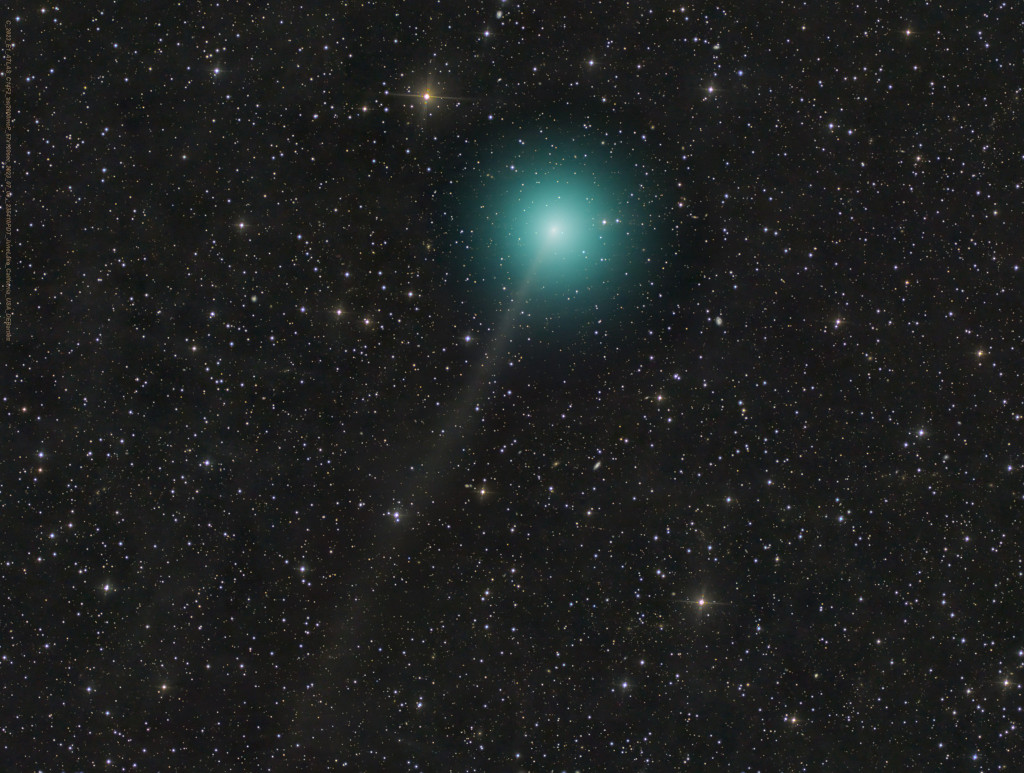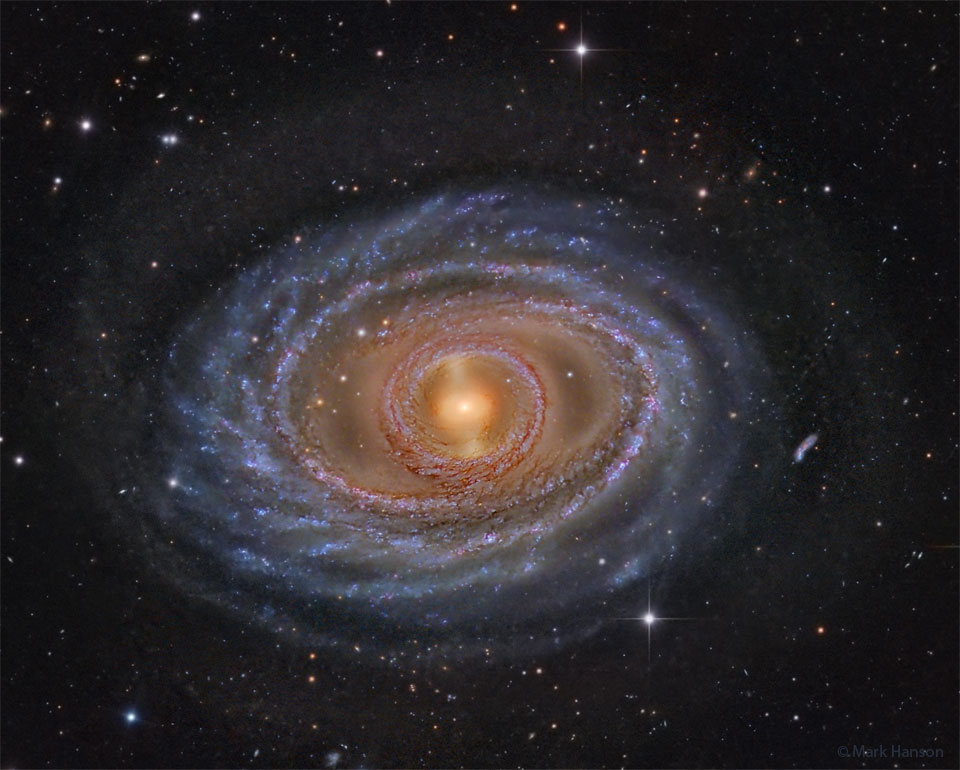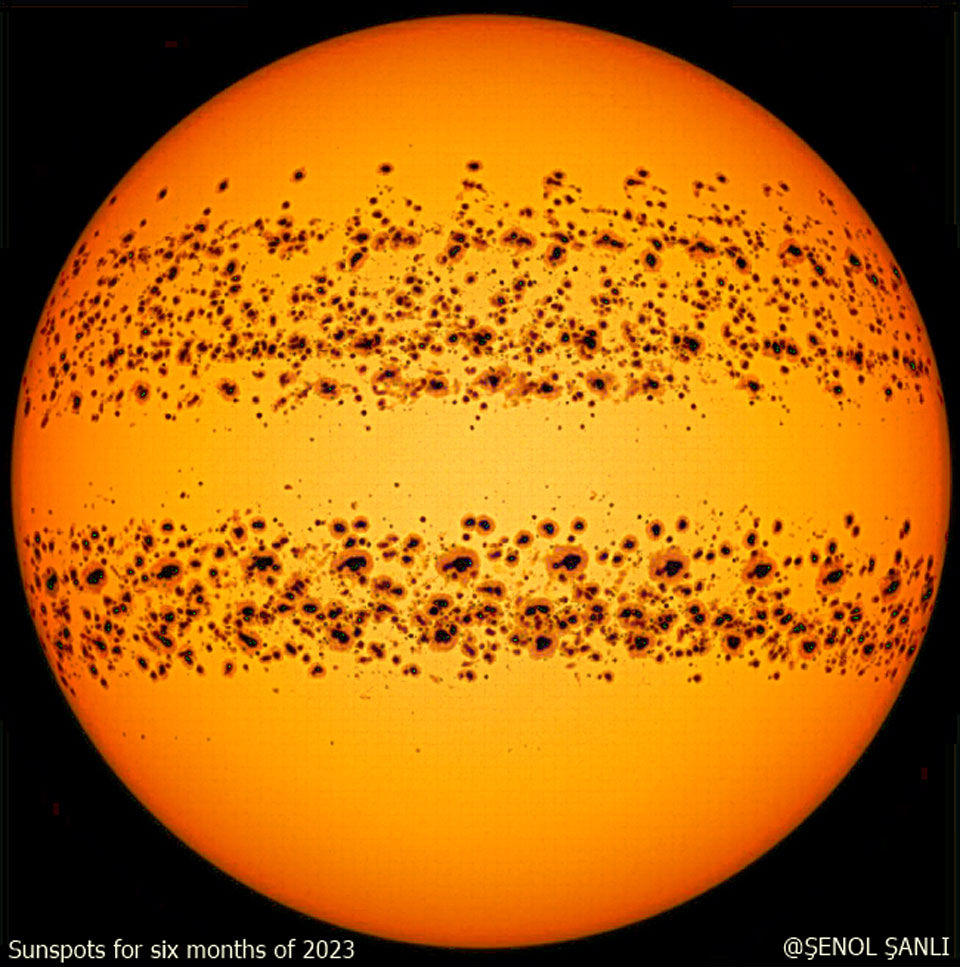Η Αστρονομική Εικόνα της Ημέρας από τη NASA
Red Sprites and Circular Elves Lightning over Italy
23/12/2025
What's happening in the sky? Lightning. The most commonly seen type of lightning involves flashes of bright white light between clouds. Over the past 50 years, though, other types of upper-atmospheric lightning have been confirmed, including tentacled red sprites and ringed ELVES. Although both last only a small fraction of a second, sprites are brighter and easier to photograph than their more common electrical-discharge cousins. ELVES are rapidly expanding rings that are thought to be created when an electromagnetic pulse shoots upward from charged clouds and impacts the ionosphere, causing nitrogen molecules to glow. Capturing either form of lightning takes patience and experience -- capturing them both together, since they usually occur separately, is rare. The featured image is a frame from a video recorded from Possagno, Italy late last month above a distant thunderstorm over the Adriatic Sea.
Copyright: Valter Binotto
Προηγούμενες Αστρονομικές Εικόνες της Ημέρας από τη NASA
Milky Way above La Palma Observatory
18/07/2023
What's happening in the night sky? To help find out, telescopes all over the globe will be pointing into deep space. Investigations will include trying to understand the early universe, finding and tracking Earth-menacing asteroids, searching for planets that might contain extra-terrestrial life, and monitoring stars to help better understand our Sun. The featured composite includes foreground and background images taken in April from a mountaintop on La Palma island in the Canary Islands of Spain. Pictured, several telescopes from the Roque de los Muchachos Observatory are shown in front of a dark night sky. Telescopes in the foreground include, left to right, Magic 1, Galileo, Magic 2, Gran Canarian, and LST. Sky highlights in the background include the central band of our Milky Way Galaxy, the constellations of Sagittarius, Ophiuchus and Scorpius, the red-glowing Eagle and Lagoon Nebulas, and the stars Alrami and Antares. Due to observatories like this, humanity has understood more about our night sky in the past 100 years than ever before in all of human history.
Copyright: Marcin Rosadziński
Shells and Arcs around Star CW Leonis
17/07/2023
What's happening around this star? No one is sure. CW Leonis is the closest carbon star, a star that appears orange because of atmospheric carbon dispersed from interior nuclear fusion. But CW Leonis also appears engulfed in a gaseous carbon-rich nebula. What causes the nebula's complexity is unknown, but its geometry of shells and arcs are surely intriguing. The featured image by the Hubble Space Telescope details this complexity. The low surface gravity of carbon stars enhances their ability to expel carbon and carbon compounds into space. Some of this carbon ends up forming dark dust that is commonly seen in the nebulas of young star-forming regions and the disks of galaxies. Humans and all Earth-based life are carbon-based, and at least some of our carbon was likely once circulating in the atmospheres of near-death stars like carbon stars.
Copyright: NASA
Meteor and Milky Way over the Alps
16/07/2023
Now this was a view with a thrill. From Mount Tschirgant in the Alps, you can see not only nearby towns and distant Tyrolean peaks, but also, weather permitting, stars, nebulas, and the band of the Milky Way Galaxy. What made the arduous climb worthwhile this night, though, was another peak -- the peak of the 2018 Perseids Meteor Shower. As hoped, dispersing clouds allowed a picturesque sky-gazing session that included many faint meteors, all while a carefully positioned camera took a series of exposures. Suddenly, a thrilling meteor -- bright and colorful -- slashed down right next to the nearly vertical band of the Milky Way. As luck would have it, the camera caught it too. Therefore, a new image in the series was quickly taken with one of the sky-gazers posing on the nearby peak. Later, all of the images were digitally combined.
Copyright: Nicholas Roemmelt (Venture Photography)
Webb's First Deep Field
15/07/2023
This stunning infrared image was released one year ago as the James Webb Space Telescope began its exploration of the cosmos. The view of the early Universe toward the southern constellation Volans was achieved in 12.5 hours of exposure with Webb's NIRCam instrument. Of course the stars with six spikes are well within our own Milky Way. Their diffraction pattern is characteristic of Webb's 18 hexagonal mirror segments operating together as a single 6.5 meter diameter primary mirror. The thousands of galaxies flooding the field of view are members of the distant galaxy cluster SMACS0723-73, some 4.6 billion light-years away. Luminous arcs that seem to infest the deep field are even more distant galaxies though. Their images are distorted and magnified by the dark matter dominated mass of the galaxy cluster, an effect known as gravitational lensing. Analyzing light from two separate arcs below the bright spiky star, Webb's NIRISS instrument indicates the arcs are both images of the same background galaxy. And that galaxy's light took about 9.5 billion years to reach the James Webb Space Telescope.
Copyright: NASA
Comet C/2023 E1 ATLAS near Perihelion
14/07/2023
Comet C/2023 E1 (ATLAS) was just spotted in March, another comet found by the NASA funded Asteroid Terrestrial-impact Last Alert System. On July 1 this Comet ATLAS reached perihelion, its closest approach to the Sun. Shortly afterwards the telescopic comet was captured in this frame sporting a pretty greenish coma and faint, narrow ion tail against a background of stars in the far northern constellation Ursa Minor. This comet's closest approach to Earth is still to come though. On August 18 this visitor to the inner Solar System will be a mere 3 light-minutes or so from our fair planet. Based on its inclination to the ecliptic plane and orbital period of about 85 years C/2023 E1 (ATLAS) is considered a Halley-type comet.
Copyright: Dan Bartlett
Webb's Rho Ophiuchi
13/07/2023
A mere 390 light-years away, Sun-like stars and future planetary systems are forming in the Rho Ophiuchi molecular cloud complex, the closest star-forming region to our fair planet. The James Webb Space Telescope's NIRCam peered into the nearby natal chaos to capture this infrared image at an inspiring scale. The spectacular cosmic snapshot was released to celebrate the successful first year of Webb's exploration of the Universe. The frame spans less than a light-year across the Rho Ophiuchi region and contains about 50 young stars. Brighter stars clearly sport Webb's characteristic pattern of diffraction spikes. Huge jets of shocked molecular hydrogen blasting from newborn stars are red in the image, with the large, yellowish dusty cavity carved out by the energetic young star near its center. Near some stars in the stunning image are shadows cast by their protoplanetary disks.
Copyright: NASA
Rings and Bar of Spiral Galaxy NGC 1398
12/07/2023
Why do some spiral galaxies have a ring around the center? Spiral galaxy NGC 1398 not only has a ring of pearly stars, gas and dust around its center, but a bar of stars and gas across its center, and spiral arms that appear like ribbons farther out. The featured deep image from Observatorio El Sauce in Chile shows the grand spiral galaxy in impressive detail. NGC 1398 lies about 65 million light years distant, meaning the light we see today left this galaxy when dinosaurs were disappearing from the Earth. The photogenic galaxy is visible with a small telescope toward the constellation of the Furnace (Fornax). The ring near the center is likely an expanding density wave of star formation, caused either by a gravitational encounter with another galaxy, or by the galaxy's own gravitational asymmetries.
Copyright: NASA
Sunspots on an Active Sun
11/07/2023
Why is our Sun so active now? No one is sure. An increase in surface activity was expected because our Sun is approaching solar maximum in 2025. However, last month our Sun sprouted more sunspots than in any month during the entire previous 11-year solar cycle -- and even dating back to 2002. The featured picture is a composite of images taken every day from January to June by NASA's Solar Dynamic Observatory. Showing a high abundance of sunspots, large individual spots can be tracked across the Sun's disk, left to right, over about two weeks. As a solar cycle continues, sunspots typically appear closer to the equator. Sunspots are just one way that our Sun displays surface activity -- another is flares and coronal mass ejections (CMEs) that expel particles out into the Solar System. Since these particles can affect astronauts and electronics, tracking surface disturbances is of more than aesthetic value. Conversely, solar activity can have very high aesthetic value -- in the Earth's atmosphere when they trigger aurora.
Copyright: NASA
Η Αστρονομική Εικόνα της Ημέρας από τη NASA (NASA Astronomy Picture of the Day) είναι μια δωρεάν υπηρεσία που παρέχει καθημερινά μια εντυπωσιακή εικόνα από το σύμπαν, την λήψη της οποίας έχει πραγματοποιήσει κάποιος από τους αστρονόμους της NASA ή από κάποιον από τους δορυφόρους ή τα τηλεσκόπια που η NASA λειτουργεί. Οι εικόνες που εμφανίζονται καλύπτουν μια ευρεία γκάμα από θέματα, συμπεριλαμβανομένων των αστερισμών, των γαλαξιών, των πλανητικών συστημάτων, των κομητών, των αστρικών σωμάτων και των παρατηρητηρίων. Κάθε εικόνα συνοδεύεται από μια σύντομη εξήγηση και πληροφορίες σχετικά με το τι παρατηρείται στην εικόνα.
